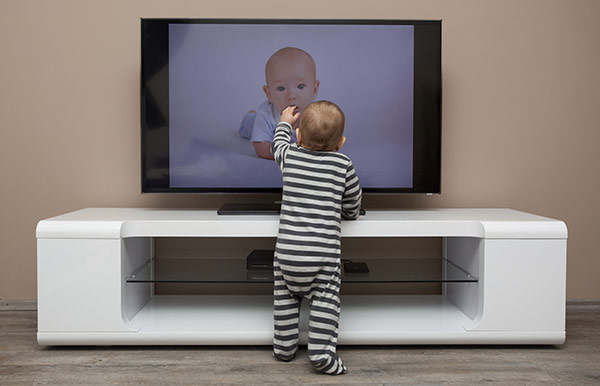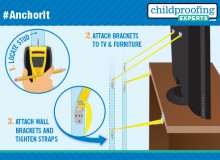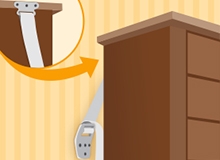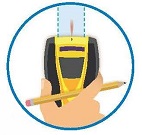
Most parents are concerned about too much screen-time when it comes to their children and TV. However, there is an even more immediate risk to their family from televisions -TV tip-overs!
Children under five years of age are at greatest risk but tip-over injuries happen to older children and even adults. Young children are drawn to the sounds and motions of the “magic” screens and try to get as close as possible, even if it means climbing to do so. Older children are often “attached” to the TV by controllers when playing video games or they knock into the TV or furniture while playing nearby, causing the tip-over.
Both older CRT “tube” TVs and flat-panel TVs can be serious home hazards if not properly placed and anchored. Flat-panel TVs tend to be top-heavy with narrow bases that can be easily tipped, pulled or knocked over. Older “tube” TVs tend to be heavier and more stable on their own, but problems occur when the TVs are moved to an unstable base or inappropriate piece of furniture.
Many homes have multiple TVs and when new TVs are purchased the older ones move to bedrooms or play areas where children could still have access. One common cause of TV tip-over is related to inappropriate locations for TVs such as tall dressers, furniture that is smaller than the television, furniture with drawers or furniture not designed for the size of the TV. A TV placed on the top of a chest of drawers or a dresser is NOT SAFE. When a child opens a drawer, climbs on a shelf, or leans on an open door, the center of gravity changes, creating a risk for a tip-over.
Anchoring Your TVs
All TVs in the home should be anchored along with the stands they are on. Use products specifically designed for television anchoring. Currently, TVs are not required to come with anchors but there are flat-screen TV anchoring products available. These products should come with an assortment of the required bolts that attach the anchoring device to the pre-threaded holes on the back of each TV. Do not drill into televisions.
Safety straps designed for anchoring TVs can be used to secure a TV to the wall studs or the back of a properly anchored piece of furniture designed to hold the size and weight of your TV. Some TV manufacturers might provide information on securing the base of a flat-screen TV to the top of the TV stand. Bases for flat screen televisions could be secured to furniture per the manufacturer’s instructions AND the furniture should be anchored.
Another option for flat-panel TVs is to install wall mounts, which are secured to the studs in the wall. Whether installing TV anchoring straps or a wall mount, attaching the anchoring device securely to the wall studs with the appropriate length screws is critical for safety. Plastic hollow wall anchors will NOT be secure enough. It may be a good idea to hire a professional for installing a wall mount, especially if you have trouble locating the wall studs, there are concrete walls, metal surfaces or any other challenges.
For older CRT TVs that do not have pre-threaded holes on the back, consider heavy-duty earthquake anchoring devices, and not smaller adhesive products. Most adhesive-mount products will not be strong enough to prevent tip-over. Recycle or donate your old TVs to keep your family safer!
When using a TV stand or entertainment center, make sure to use an appropriate one that is designed to support the size and weight of the TV. The TV should be placed on a sturdy, low base and pushed back as far as possible. Even when using the correct stand or base for your TV, it should be anchored correctly. All cords should be hidden and secured so that children cannot grab or pull on them (to keep what’s attached to them from falling down on the child).
Avoid placing any items on top of the TV that might attract a curious child, such as toys, games, DVDs, and remote controls.
Remember, tip-over injuries are preventable. Even when supervised, curious or active children quickly find trouble. While tip-overs can happen in any home, there are simple steps parents and grandparents can take today to keep their children safe. Protect your children and Anchor your TVs!
Learn how to properly anchor your televisions in our TV safety infographic.
Click here to view in Spanish.
Article updated August 2021




